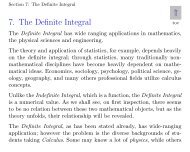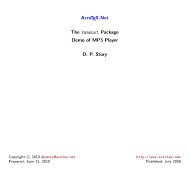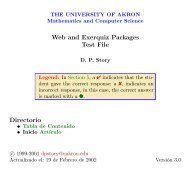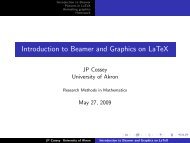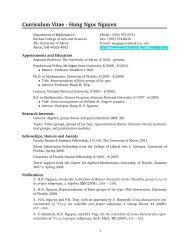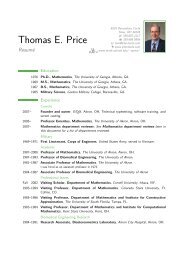Inquiry Based Lesson – Adding Integers using Integer Chips Jackie ...
Inquiry Based Lesson – Adding Integers using Integer Chips Jackie ...
Inquiry Based Lesson – Adding Integers using Integer Chips Jackie ...
You also want an ePaper? Increase the reach of your titles
YUMPU automatically turns print PDFs into web optimized ePapers that Google loves.
Project AMP Dr. Antonio R. Quesada <strong>–</strong> Director, Project AMP<br />
<strong>Inquiry</strong> <strong>Based</strong> <strong>Lesson</strong> <strong>–</strong> <strong>Adding</strong> <strong><strong>Integer</strong>s</strong> <strong>using</strong> <strong>Integer</strong> <strong>Chips</strong><br />
<strong>Jackie</strong> Wolf<br />
Pat Canterbury<br />
Part I<br />
1. <strong>Lesson</strong> Title: <strong>Adding</strong> integers <strong>using</strong> integer chips<br />
2. <strong>Lesson</strong> Summary: In this lesson, students will use integer chips and mats to<br />
“discover” the rules for adding integers. By modeling the addition of integers <strong>using</strong><br />
black and white chips (black = - 1, white = +1) and the concept of “zero pairs”,<br />
students will find the sum of given addition exercises by modeling and recording<br />
answers in a table. The students will then look for patterns and conjecture. Finally,<br />
students will be asked to generalize how to add any two integers.<br />
3. Key Words: <strong><strong>Integer</strong>s</strong>, modeling, zero pairs, addition, integer chips<br />
4. Background knowledge: Students must know what an integer is as well as how to<br />
use a number line to plot integers. Students understand absolute value of numbers.<br />
5. NCTM Standards: Number and Number Operations: Understand meaning and<br />
effects of arithmetic operations with fractions, decimals and integers.<br />
6. Learning Objectives: Student will be able to model integer addition <strong>using</strong> integer<br />
chips. Student will be able to discover rules for addition of integers.<br />
7. Materials: Black and white poker chips <strong>–</strong> 15 each per pair, 9 X 11 construction paper<br />
for mat, student lesson sheet.<br />
8. Suggested Procedure:<br />
a. Attention getter: Present problems on the board: 136 + - 83 = and<br />
- 24 + 31 + - 17 =. Ask students to solve the two problems. Ask for students to<br />
explain their reasoning. Do not give correct answer.<br />
b. Grouping: students work in pairs<br />
9. Assessments: Teacher observation during activity, collect student lesson sheets to<br />
review work. At a later date <strong>–</strong> formal assessment (quiz or test) to check student’s<br />
ability to add integers.
Project AMP Dr. Antonio R. Quesada <strong>–</strong> Director, Project AMP<br />
Part II<br />
1. <strong>Lesson</strong> Title <strong>–</strong> <strong>Adding</strong> integers <strong>using</strong> integer chips<br />
2. Team member’s names - <strong>Jackie</strong> Wolf, Pat Canterbury<br />
File name: <strong>Adding</strong> <strong><strong>Integer</strong>s</strong><br />
3. <strong>Lesson</strong>’s goals: Students will develop a method for adding integers.<br />
4. Investigation:<br />
Introduction for students:<br />
You have been given black and white poker chips. Each black chip represents<br />
-1 and each white chip represents + 1. You will be <strong>using</strong> these chips to model<br />
adding integers.<br />
You have also been given a piece of construction paper. This is your mat. All of<br />
you modeling will be done on this mat. Notice the black line dividing the paper, this<br />
is to separate your two addends. Be sure to start every new exercise with an empty<br />
mat.<br />
Remember adding means combining two sets.<br />
Example: 2 + 3 means adding a set of 2 to a set of 3.<br />
Lastly, it is imperative to note that one black chip and one white chip cancel each<br />
out. So<br />
+<br />
has a value of 0<br />
Use your mat to model the given problems.<br />
a. Can you model on your mat the value of 0 <strong>using</strong> eight chips?<br />
Draw a sketch on the paper to show your model.<br />
b. Using your mat and chips, model 5 + 6. Do this and then answer the<br />
question.<br />
5+ 6 = ______
Project AMP Dr. Antonio R. Quesada <strong>–</strong> Director, Project AMP<br />
c. Using your mat and chips model -5 + -6. Do this and then answer the<br />
question.<br />
-5 + -6 = ______<br />
d. Using your mat and chips model -5 + 6. Do this and then answer the<br />
questions.<br />
Can you make any zero pairs?<br />
_____________________________________________________<br />
What is the total value on your mat?<br />
______________________________________________________<br />
5 + 6 = __________<br />
-<br />
e. Using your mat and chips, model 5 + - 6. Do this and then answer<br />
the questions.<br />
Can you make any zero pairs?<br />
________________________________________________________<br />
What is the total value on your mat?<br />
________________________________________________________<br />
5 + - 6 = _________
Project AMP Dr. Antonio R. Quesada <strong>–</strong> Director, Project AMP<br />
f. Fill in the table below<br />
Addends Sum<br />
5 + 6<br />
-5 + -6<br />
-5 + 6<br />
5 + -6<br />
g. Examine your sums from the table above. Do you notice any patterns?<br />
If so, what?<br />
____________________________________________________________<br />
______________________________________________________________<br />
______________________________________________________________<br />
h. Now use your mat and chips to model and solve the following.<br />
Complete both tables.<br />
Addends Sum<br />
5 + 2<br />
5 + - 2<br />
- 5 + 2<br />
- 5 + - 2<br />
Addends Sum<br />
-7 + 4<br />
7 + 4<br />
-7 + - 4<br />
7 + - 4<br />
i. Suppose you add a positive number and a negative number. How do<br />
you use zero pairs to find the sum?<br />
______________________________________________________________
Project AMP Dr. Antonio R. Quesada <strong>–</strong> Director, Project AMP<br />
j. How are these two problems the same?<br />
5 <strong>–</strong> 2 and 5 + ( - 2)<br />
___________________________________________________________<br />
___________________________________________________________<br />
How are they different?<br />
___________________________________________________________<br />
___________________________________________________________<br />
Can you draw a conclusion about subtraction and adding a negative?<br />
___________________________________________________________<br />
___________________________________________________________<br />
k. Can you write a rule for adding two positive numbers?<br />
___________________________________________________________<br />
___________________________________________________________<br />
<strong>Adding</strong> two negative numbers? __________________________________<br />
___________________________________________________________<br />
<strong>Adding</strong> a negative number and a positive number? __________________<br />
___________________________________________________________<br />
l. Now go back to our original question. Suppose you are trying to add<br />
136 + - 89. You don’t have that many chips. How do your rules help<br />
you to solve these problems?<br />
___________________________________________________________<br />
___________________________________________________________<br />
m. Repeat with the problem -24 + 31 + - 17. How will you solve this<br />
problem?<br />
___________________________________________________________
Project AMP Dr. Antonio R. Quesada <strong>–</strong> Director, Project AMP<br />
n. In “The Invaders from Venus” video game a player must maintain a<br />
point level of 600 points. If the player’s score falls below 600 points<br />
the player is penalized 50 points during that round. At the beginning of<br />
the round, the player has 1950 points. At the end of the round he has<br />
530 points. During that round the player lost 1500 points. How many<br />
points did he earn in the round? Show your work.
Project AMP Dr. Antonio R. Quesada <strong>–</strong> Director, Project AMP<br />
Part III: Solution for the investigation:<br />
1. <strong>Lesson</strong> Title <strong>–</strong> <strong>Adding</strong> integers <strong>using</strong> integer chips<br />
2. Team member’s names - <strong>Jackie</strong> Wolf, Pat Canterbury<br />
File name: <strong>Adding</strong> <strong><strong>Integer</strong>s</strong><br />
3. <strong>Lesson</strong>’s goals: Students will develop a method for adding integers.<br />
4. Investigation:<br />
a. You will be <strong>using</strong> your mat to model the given problems.<br />
Can you model on your mat the value of 0 <strong>using</strong> eight chips?<br />
(Students should place 4 white <strong>–</strong> positive chips<br />
and 4 black <strong>–</strong> negative chips on their mat the<br />
positive and the negative chips will cancel each other out to make 0<br />
b. Using your mat and chips, model 5 + 6. Do this and then answer the<br />
question. (Students should place 5 white and 6 white chips on mat.)<br />
5 + 6 = _+ 11___<br />
c. Using your mat and chips model -5 + -6. Do this and then answer the<br />
question. (Students should place 5 black and 6 black chips on the mat.)<br />
-5 + -6 = _- 11___
Project AMP Dr. Antonio R. Quesada <strong>–</strong> Director, Project AMP<br />
d. Using your mat and chips model -5 + 6. Do this and then answer the<br />
question. (Students should have 5 black and 6 white chips)<br />
Can you make any zero pairs?<br />
_Yes, a white chip can be paired with a black chip to form 5 zero pairs.___<br />
What is the total value on your mat?<br />
__+ 1 a white chip remains_____________________________________<br />
-5 + 6 = __1___<br />
e. Using your mat and chips, model 5 + - 6. Do this and then answer the<br />
question. (Students should have 5 white and 6 black chips)<br />
Can you make any zero pairs?<br />
_ Yes, 5 zero pairs can be formed_______________________________<br />
What is the total value on your mat?<br />
__-1 a black chip remains______________________________________<br />
5 + -6 = __- 1 __<br />
f. Fill in the table below.<br />
Addends Sum<br />
5 + 6 + 11<br />
-5 + -6 - 11<br />
-5 + 6 + 1<br />
5 + -6 - 1
Project AMP Dr. Antonio R. Quesada <strong>–</strong> Director, Project AMP<br />
g. Examine the sums from the table above. Do you notice any patterns? If<br />
so, what?<br />
Students should notice that when you add two positive integers: the sum is<br />
positive. When you add two negative integers: the sum is negative. When_<br />
you add a positive and a negative integer: the sum may be positive or_____<br />
negative. _____________________________________________________<br />
h. Now use your mat and chips to model the following.<br />
Complete both tables.<br />
Addends Sum<br />
5 + 2 +7<br />
5 + - 2 +3<br />
- 5 + 2 - 3<br />
- 5 + - 2 - 7<br />
Addends Sum<br />
-7 + 4 - 3<br />
7 + 4 + 11<br />
-7 + - 4 - 11<br />
7 + - 4 + 3<br />
i. Suppose you add a positive number and a negative number. How do you<br />
use zero pairs to find the sum?<br />
__(match up a white and black chip to form as many zero pairs as you can,<br />
when all zero pairs have been formed, the sum is what is left on your mat, the<br />
sign is positive or negative depending on the color of the chip that is left.<br />
White is positive, black is negative. _________________________________<br />
j. How are these two problems the same?<br />
5 <strong>–</strong> 2 and 5 + ( - 2)<br />
__Both have an answer of + 3 _______________________________<br />
How are they different?<br />
___One is a subtraction problem, one is an addition problem. __________<br />
Can you draw a conclusion about subtraction and adding a negative<br />
number?<br />
__<strong>Adding</strong> a negative yields the same result as subtraction.____________
Project AMP Dr. Antonio R. Quesada <strong>–</strong> Director, Project AMP<br />
k. Write a rule for adding two positive numbers.<br />
___To add two positive numbers: add the absolute value of the two<br />
numbers and the sum is positive. ___________________________<br />
<strong>Adding</strong> two negative numbers? _To add two negative numbers: add the__<br />
absolute value of the two numbers and the sum is negative. _________ _<br />
<strong>Adding</strong> a negative number and a positive number? __To add a positive<br />
and a negative number: subtract the two absolute values and the sum<br />
carries the sign of the greater absolute value number.<br />
l. Now go back to our original questions. Suppose you are trying to add<br />
136 + - 89. You don’t have that many chips. Use your rules to find the<br />
solution.<br />
___Subtract 136 <strong>–</strong> 89 the answer is 56. Now decide whether the sum is<br />
positive or negative, since 136 is the greater absolute value and it is a ___<br />
positive number the sum of 136 + - 80 = + 56. _________________<br />
m. Repeat with -24 + 31 + -17. How will you solve this problem?<br />
__ The problem can be done in two steps. First solve <strong>–</strong>24 + 31. Subtract<br />
31 - 24 get 7 which is negative 7, because 31 has the greater absolute<br />
value, the answer to this part is -7. Then use the -7 to add to the -17.<br />
Since both are negative add the two numbers together to get 24 and the<br />
24 carries a negative sign since both addends are negative.<br />
n. In “The Invaders from Venus” video game a player must maintain a<br />
point level of 600 points. If the player’s score falls below 600 points<br />
the player is penalized 50 points during that round. At the beginning of<br />
the round, the player has 1950 points. At the end of the round he has<br />
530 points. During that round the player lost 1500 points. How many<br />
points did he earn in the round? Show your work.<br />
First, add the initial 1950 points and the <strong>–</strong> 1500 points the player lost.<br />
1950 + - 1500 = 450. Then take into account that the player is penalized<br />
50 points for falling below 600 points. So add -50 points to 450.<br />
450 + - 50 = 400. To determine how many points the player earned in the<br />
round take his score at the end of the game of 530 and the <strong>–</strong> 400 points<br />
the player lost. 530 + -400 = 130



